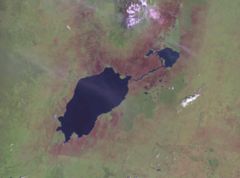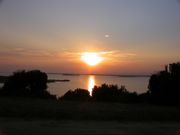Lake Edward
2007 Schools Wikipedia Selection. Related subjects: African Geography
| Lake Edward | |
|---|---|
|
|
|
| Coordinates | |
| Primary sources | Nyamugasani Ishasha Rutshuru Rwindi |
| Primary outflows | Semliki River Kazinga Channel |
| Catchment area | 12,096 km² |
| Basin countries | Democratic Republic of Congo Uganda |
| Max-length | 77 km |
| Max-width | 40 km |
| Surface area | 2,325 km² |
| Average depth | 17m |
| Max-depth | 112m |
| Water volume | 39.5km³ |
| Surface elevation | 912 m |
Lake Edward is one of the Great Lakes of Africa. It is located in the Great Rift Valley, on the border between the Democratic Republic of the Congo and Uganda, its northern banks a few kilometers south of the Equator. The lake was visited by Henry Morton Stanley in 1888 and was named by him in honour of Albert Edward, the Prince of Wales. The lake was later named Lake Idi Amin or Lake Idi Amin Dada after Ugandan dictator Idi Amin, today it is again known as Lake Edward.
Lake Edward is fed by the Nyamugasani, the Ishasha, the Rutshuru, and the Rwindi rivers. It empties to the north via the Semliki River into Lake Albert. It is also connected, by means of the Kazinga Channel, to Lake George to the northeast. It stands at an elevation of 920 metres, is 77 km long by 40 km wide at its maximum points, and covers a total surface area of 2,325 km² (the 15th largest on the continent).
Ecology
Lake Edward is home to many species of fish, including populations of Bagrus docmac, Sarotherodon niloticus, Sarotherodon leucostictus, and over 50 species of Haplochromis and Haplochromis related species, of which only 8 are formally described. Fishing is an important activity among local residents. Fauna living on the banks of the lake – including chimpanzees, elephants, crocodiles, and lions – are protected by the Virunga National Park (Congo) and the Queen Elizabeth National Park (Uganda). The area is also home to many perennial and migratory bird species.


